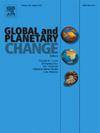西秦岭新生代造山活动及其与黄土高原最早风成红粘土形成的关系
IF 4
1区 地球科学
Q1 GEOGRAPHY, PHYSICAL
引用次数: 0
摘要
大型风成沉积区内最早的风成沉积通常被认为是大气格局初始干旱化和重组的标志。然而,风沙沉积不仅受到风沙源区气候变化的影响,还受到沙尘输送路径沿线地形变化的影响,这是一个经常被忽视的因素。中国黄土高原(CLP)是东亚地区最大的沙尘堆积区,以回飞镖形状的山脉为界。利用磷灰石(UTh)/He热年代学和热模拟,重建了西秦岭造山带的隆升历史,该造山带与中国大陆最早(25-22 Ma)风成红粘土相邻。研究结果表明,西秦岭在晚渐新世-中新世早期经历了构造隆升,与中关带最早风成红粘土的形成同时发生。考虑到中关带周围的构造活动和中亚和太平洋地区最新的气候记录,我们认为中关带晚渐新世-早中新世风成红粘土的出现可能反映了有利于粉尘堆积和保存的地貌条件的形成。这种现象不仅限于东亚,在其他活动造山带也普遍存在。因此,在评价初期风成沉积的地质意义时,特别是在活动造山带中,应当谨慎。本文章由计算机程序翻译,如有差异,请以英文原文为准。
Cenozoic mountain building of the West Qinling and its correlation with formation of the earliest eolian red clays in the Chinese Loess Plateau
The earliest eolian deposits in large-scale eolian depositional regions are typically regarded as the indicators of the initial aridification and reorganization of the atmospheric pattern. However, eolian deposition is influenced not only by climatic changes in source regions, but also by the topography evolution along dust transportation pathways, a factor often overlooked. The Chinese Loess Plateau (CLP) is the largest dust accumulation region in East Asia, which is bounded by boomerang-shaped mountains. Here, we used apatite (U![]() Th)/He thermochronology and thermal modeling to reconstruct the uplift history of the West Qinling, an orogenic belt adjacent to the earliest (25–22 Ma) eolian red clays in the CLP. Our findings indicate that the West Qinling experienced tectonic uplift during the late Oligocene-early Miocene, coeval with the formation of the earliest eolian red clays in the CLP. Considering the tectonic activities surrounding the CLP and updated climatic records in Central Asia and Pacific Ocean, we propose that the appearance of the late Oligocene-early Miocene eolian red clays in the CLP likely reflects the formation of geomorphologic conditions conductive to dust accumulation and preservation. This phenomenon is not limited to East Asia, but is also commonly observed in other active orogenic belts. Thus, it ought to be cautious to assess the geological significance of the initial eolian deposition, particularly in active orogenic belts.
Th)/He thermochronology and thermal modeling to reconstruct the uplift history of the West Qinling, an orogenic belt adjacent to the earliest (25–22 Ma) eolian red clays in the CLP. Our findings indicate that the West Qinling experienced tectonic uplift during the late Oligocene-early Miocene, coeval with the formation of the earliest eolian red clays in the CLP. Considering the tectonic activities surrounding the CLP and updated climatic records in Central Asia and Pacific Ocean, we propose that the appearance of the late Oligocene-early Miocene eolian red clays in the CLP likely reflects the formation of geomorphologic conditions conductive to dust accumulation and preservation. This phenomenon is not limited to East Asia, but is also commonly observed in other active orogenic belts. Thus, it ought to be cautious to assess the geological significance of the initial eolian deposition, particularly in active orogenic belts.
求助全文
通过发布文献求助,成功后即可免费获取论文全文。
去求助
来源期刊

Global and Planetary Change
地学天文-地球科学综合
CiteScore
7.40
自引率
10.30%
发文量
226
审稿时长
63 days
期刊介绍:
The objective of the journal Global and Planetary Change is to provide a multi-disciplinary overview of the processes taking place in the Earth System and involved in planetary change over time. The journal focuses on records of the past and current state of the earth system, and future scenarios , and their link to global environmental change. Regional or process-oriented studies are welcome if they discuss global implications. Topics include, but are not limited to, changes in the dynamics and composition of the atmosphere, oceans and cryosphere, as well as climate change, sea level variation, observations/modelling of Earth processes from deep to (near-)surface and their coupling, global ecology, biogeography and the resilience/thresholds in ecosystems.
Key criteria for the consideration of manuscripts are (a) the relevance for the global scientific community and/or (b) the wider implications for global scale problems, preferably combined with (c) having a significance beyond a single discipline. A clear focus on key processes associated with planetary scale change is strongly encouraged.
Manuscripts can be submitted as either research contributions or as a review article. Every effort should be made towards the presentation of research outcomes in an understandable way for a broad readership.
 求助内容:
求助内容: 应助结果提醒方式:
应助结果提醒方式:


